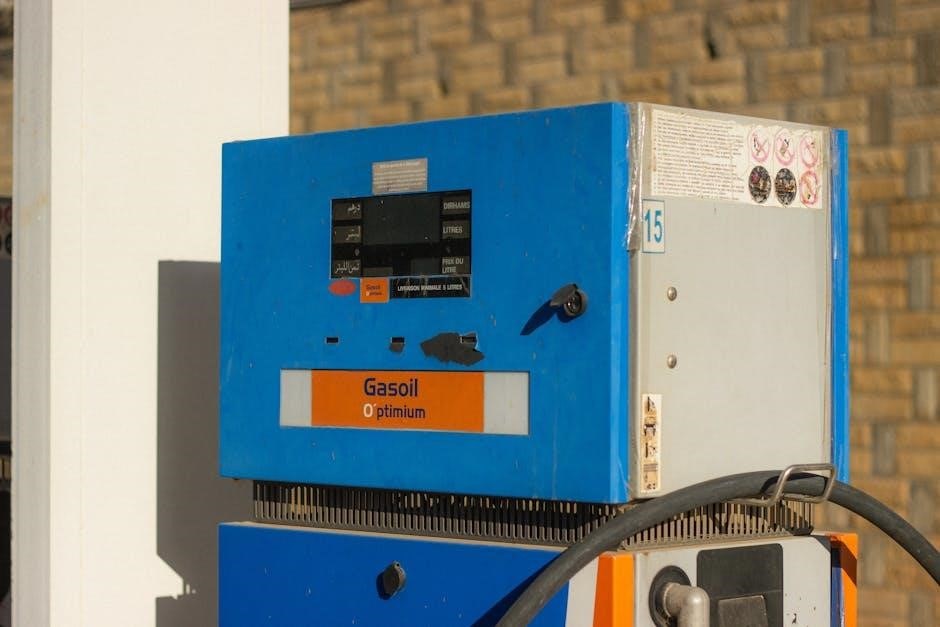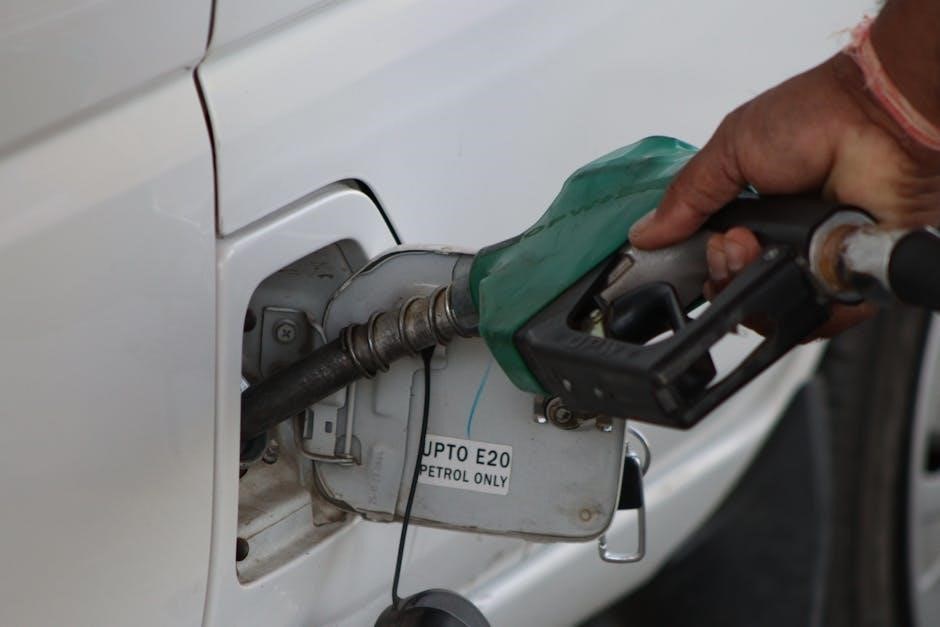Manual gas transfer pumps are essential tools for fuel management, offering a portable and reliable solution for transferring liquids without electricity. They are widely used in residential, commercial, and industrial settings, providing an efficient way to handle fuels, oils, and other fluids. These pumps are designed for low-volume applications, making them ideal for small-scale operations or emergency situations. Their simplicity and durability ensure they remain a popular choice for various environments, including remote locations where power sources are unavailable.
1.1 Overview of Manual Gas Transfer Pumps
Manual gas transfer pumps are portable, non-electric devices designed for transferring fuels, oils, and other liquids. They operate via a hand-powered mechanism, making them ideal for small-scale or emergency use. These pumps are lightweight, durable, and easy to use, offering a reliable solution for environments without access to electricity. They are commonly used in residential, commercial, and industrial settings for efficient fluid management.
1.2 Importance in Fuel Management
Manual gas transfer pumps play a crucial role in fuel management by providing a reliable, portable solution for transferring fuels safely and efficiently. They are essential for emergency preparedness, small-scale operations, and environments without electricity. These pumps help prevent fuel waste, reduce spillage risks, and ensure consistent fuel supply in residential, commercial, and industrial settings, making them a vital tool for effective fuel distribution and management.
Key Components of a Manual Gas Transfer Pump
A manual gas transfer pump consists of a piston and cylinder, inlet and outlet valves, intake and outlet hoses, and a handle mechanism. These components work together to facilitate efficient fuel transfer, ensuring reliable operation and durability in various applications.
2.1 Piston and Cylinder Assembly
The piston and cylinder assembly is the heart of the manual gas transfer pump, enabling the creation of suction and discharge strokes. The piston moves up and down within the cylinder, driven by the handle mechanism, to draw fuel into the pump and push it out through the outlet. This assembly ensures efficient fuel transfer and is critical for maintaining pump performance and longevity.
2.2 Inlet and Outlet Valves
The inlet and outlet valves are crucial components of the manual gas transfer pump, ensuring proper fuel flow direction. The inlet valve allows fuel to enter the pump during the suction stroke, while the outlet valve prevents backflow by opening only during the discharge stroke. These valves are essential for maintaining efficient and leak-free operation, ensuring fuel is transferred reliably without contamination or loss of pressure.
2.3 Intake and Outlet Hoses
Intake and outlet hoses are flexible, durable connections essential for transferring fuel safely and efficiently. The intake hose draws fuel from the source container, while the outlet hose directs it to the destination. Both hoses are typically constructed from fuel-resistant materials to prevent leaks and degradation. Bendable intake hoses are especially useful for reaching deep into fuel containers, ensuring complete transfers without spills or contamination.
2.4 Handle and Lever Mechanism
The handle and lever mechanism are critical components of manual gas transfer pumps, enabling easy operation; The handle provides a comfortable grip, while the lever amplifies force to create suction and pressurize the system. Ergonomic designs reduce fatigue during prolonged use. Durable materials ensure long-lasting performance, making these mechanisms essential for reliable fuel transfer in various settings.
Working Principle of a Manual Gas Transfer Pump
Manual gas transfer pumps operate by creating suction and pressure through a piston-driven mechanism. The handle and lever convert manual effort into energy to transfer fluids efficiently.
3.1 Suction Stroke Operation
The suction stroke begins when the piston is pulled upward, creating a vacuum inside the cylinder. This vacuum pressure opens the inlet valve, allowing fuel to flow into the pump chamber. The intake hose draws the liquid from the source, such as a gas can or tank, into the pump. This process is crucial for initiating the transfer of fuel, ensuring the pump is primed and ready for discharge.
3.2 Discharge Stroke Functionality
During the discharge stroke, the piston moves downward, generating pressure that forces fuel through the outlet valve and into the discharge hose. This pressure-driven flow directs the liquid to its destination, such as a vehicle or storage container. The discharge stroke ensures efficient transfer of fuel, maintaining control over the flow rate and preventing spillage, making it a critical phase in the pumping process.
3.3 Role of Check Valves
Check valves play a vital role in a manual gas transfer pump by ensuring fluid flows in one direction only. They prevent backflow during the suction and discharge strokes, maintaining pressure and efficiency. This prevents fuel from returning to the cylinder, allowing smooth operation and protecting the pump from potential damage caused by reversed flow, ensuring reliable performance and longevity of the pump system.
Safety and Maintenance Tips
Always handle manual gas transfer pumps with caution, ensuring proper grounding and operation in well-ventilated areas. Regularly inspect and clean components, checking for wear and tear to maintain efficiency and safety during use.
4.1 Safety Precautions During Operation
Always wear protective gloves and safety glasses when operating a manual gas transfer pump. Ensure the area is well-ventilated to prevent gas fumes accumulation. Avoid smoking or open flames nearby. Properly ground the equipment to prevent static electricity risks. Keep the pump away from ignition sources and follow the manufacturer’s guidelines for safe operation. Regularly inspect hoses and connections for leaks or damage before use.
4.2 Regular Maintenance Practices
Regularly inspect the pump for leaks and damage, especially around seals and hoses. Clean the pump after each use to prevent contamination. Lubricate moving parts periodically to ensure smooth operation. Check and replace worn-out components like valves or gaskets as needed. Store the pump in a dry, protected area when not in use to maintain its functionality and longevity. Always follow the manufacturer’s maintenance recommendations for optimal performance.
Applications of Manual Gas Transfer Pumps
Manual gas transfer pumps are widely used in residential, commercial, and industrial settings for fueling equipment, vehicles, and storage tanks. They are ideal for small-scale fuel needs, agricultural applications, and emergency preparedness scenarios where electricity is unavailable. Their portability and reliability make them essential for various fluid transfer tasks in diverse environments.
5.1 Residential and Commercial Use Cases
In residential settings, manual gas transfer pumps are often used for refueling lawn mowers, generators, and other small equipment. In commercial environments, they serve as reliable tools for managing fuel supplies, transferring liquids between storage containers, and supporting fleet maintenance. Their compact design and ease of use make them ideal for both small-scale and medium-duty applications, ensuring efficient fuel management without the need for electricity.
5.2 Industrial and Agricultural Applications
Manual gas transfer pumps are widely used in industrial and agricultural settings for fueling machinery, tractors, and generators. Their portability and reliability make them ideal for remote locations where electricity is unavailable; In industrial environments, they facilitate efficient liquid transfers between storage tanks and equipment, while in agriculture, they support fueling operations for farming machinery, ensuring uninterrupted workflow and productivity.
5.3 Emergency Preparedness
Manual gas transfer pumps are indispensable in emergency preparedness, serving as reliable tools for fuel transfer during power outages or natural disasters. Their portability and ability to operate without electricity make them essential for disaster response. These pumps ensure fuel availability for backup generators, vehicles, and critical equipment, providing a lifeline in situations where fuel access is limited or unavailable.

Choosing the Right Manual Gas Transfer Pump

Selecting the ideal manual gas transfer pump involves considering flow rate, fuel compatibility, and durability to ensure efficient and reliable operation for your specific needs.
6.1 Factors to Consider in Selection
When selecting a manual gas transfer pump, consider flow rate, fuel compatibility, and durability. Ensure the pump suits your application, whether residential, commercial, or industrial. Portability and ease of use are crucial, especially for frequent relocations. Additionally, evaluate safety features and maintenance requirements to ensure long-term efficiency and reliability in various environmental conditions.
6.2 Flow Rate and Compatibility
Assessing the flow rate is crucial to ensure the pump meets your fuel transfer needs. Look for models like the TERA PUMP TRM20, which can transfer up to 3.2 gallons per minute. Additionally, check compatibility with your fuel type, such as gasoline, diesel, or oil. Using a pump with incompatible fuels can damage the equipment or pose safety risks. Always select a pump designed for your specific application to ensure efficiency and safety.
6.3 Durability and Portability
Durability and portability are key factors when selecting a manual gas transfer pump. Look for models constructed with high-quality, corrosion-resistant materials like stainless steel or durable plastics. Portability is enhanced with lightweight designs, compact frames, and ergonomic handles. These features ensure easy transportation and storage, making the pump suitable for both stationary and mobile fueling needs. Durable pumps also withstand harsh environments and extended use.

Troubleshooting Common Issues
Common issues with manual gas transfer pumps include low flow rates, failure to prime, or leakage. Check for blockages, air leaks, or worn-out valves. Priming the pump with a syringe or replacing faulty components often resolves these problems. Regular inspection and maintenance can prevent malfunctions and ensure smooth operation.
7.1 Identifying and Resolving Pump Malfunctions
Identifying malfunctions in manual gas transfer pumps often involves checking for low flow rates or leakage. Common issues include clogged hoses, worn-out valves, or air leaks. To resolve these, inspect the pump’s components, clean or replace faulty parts, and ensure proper priming. Regular lubrication of moving parts and checking for blockages can prevent future malfunctions, ensuring efficient operation.
7.2 Leakage and Low Flow Rate Solutions
Leakage and low flow rates in manual gas transfer pumps can be addressed by inspecting and replacing worn-out seals or gaskets. Ensure all connections are tight and free from blockages. Priming the pump by drawing fuel through the intake hose can resolve low flow issues. Regularly checking for debris in the valves and hoses also helps maintain optimal performance and prevents future malfunctions.

Compliance with Regulations
Manual gas transfer pumps must comply with safety and environmental standards to ensure safe operation and minimize ecological impact. Adherence to local and industry regulations is crucial, with pumps designed to meet specific legal requirements for fuel handling and storage. Regular inspections and certifications ensure ongoing compliance, protecting users and the environment effectively.
8.1 Adherence to Safety Standards
Manual gas transfer pumps must adhere to strict safety standards to prevent accidents and ensure safe operation. They are designed to meet global safety regulations, including explosion-proof ratings and anti-static materials. Regular testing and certification ensure compliance with industry norms, reducing the risk of fuel spills and fires. Proper materials and constructions are used to handle hazardous liquids safely and reliably.
8.2 Environmental and Legal Compliance
Manual gas transfer pumps are designed to meet environmental regulations by preventing leaks and spills, ensuring safe handling of hazardous liquids. They comply with legal standards through certifications, adhering to strict guidelines to minimize ecological impact. Proper construction and materials ensure they meet regulatory requirements, guaranteeing safe and lawful operation across various applications.
Manual gas transfer pumps are reliable, efficient tools essential for safe and effective fuel management. Their versatility in applications and compliance with standards make them indispensable in various settings.
9.1 Summary of Key Points
Manual gas transfer pumps are essential tools for efficient fuel management, offering reliability and durability. Their simple design ensures safe operation, while their portability and versatility make them suitable for various residential, commercial, and industrial applications. Compliance with safety standards and proper maintenance practices further enhance their effectiveness, making them a vital solution for fuel transfer needs across different environments.
9;2 Final Thoughts on Manual Gas Transfer Pumps
Manual gas transfer pumps are reliable and versatile tools, ideal for fuel management across various environments. Their ease of use, durability, and portability make them essential for residential, commercial, and industrial applications. Whether for routine tasks or emergency preparedness, these pumps provide a practical solution for safe and efficient liquid transfer, ensuring they remain an indispensable asset in many settings.
